Wei Xue
PodEval: A Multimodal Evaluation Framework for Podcast Audio Generation
Oct 01, 2025Abstract:Recently, an increasing number of multimodal (text and audio) benchmarks have emerged, primarily focusing on evaluating models' understanding capability. However, exploration into assessing generative capabilities remains limited, especially for open-ended long-form content generation. Significant challenges lie in no reference standard answer, no unified evaluation metrics and uncontrollable human judgments. In this work, we take podcast-like audio generation as a starting point and propose PodEval, a comprehensive and well-designed open-source evaluation framework. In this framework: 1) We construct a real-world podcast dataset spanning diverse topics, serving as a reference for human-level creative quality. 2) We introduce a multimodal evaluation strategy and decompose the complex task into three dimensions: text, speech and audio, with different evaluation emphasis on "Content" and "Format". 3) For each modality, we design corresponding evaluation methods, involving both objective metrics and subjective listening test. We leverage representative podcast generation systems (including open-source, close-source, and human-made) in our experiments. The results offer in-depth analysis and insights into podcast generation, demonstrating the effectiveness of PodEval in evaluating open-ended long-form audio. This project is open-source to facilitate public use: https://github.com/yujxx/PodEval.
WoW: Towards a World omniscient World model Through Embodied Interaction
Sep 26, 2025Abstract:Humans develop an understanding of intuitive physics through active interaction with the world. This approach is in stark contrast to current video models, such as Sora, which rely on passive observation and therefore struggle with grasping physical causality. This observation leads to our central hypothesis: authentic physical intuition of the world model must be grounded in extensive, causally rich interactions with the real world. To test this hypothesis, we present WoW, a 14-billion-parameter generative world model trained on 2 million robot interaction trajectories. Our findings reveal that the model's understanding of physics is a probabilistic distribution of plausible outcomes, leading to stochastic instabilities and physical hallucinations. Furthermore, we demonstrate that this emergent capability can be actively constrained toward physical realism by SOPHIA, where vision-language model agents evaluate the DiT-generated output and guide its refinement by iteratively evolving the language instructions. In addition, a co-trained Inverse Dynamics Model translates these refined plans into executable robotic actions, thus closing the imagination-to-action loop. We establish WoWBench, a new benchmark focused on physical consistency and causal reasoning in video, where WoW achieves state-of-the-art performance in both human and autonomous evaluation, demonstrating strong ability in physical causality, collision dynamics, and object permanence. Our work provides systematic evidence that large-scale, real-world interaction is a cornerstone for developing physical intuition in AI. Models, data, and benchmarks will be open-sourced.
PersonaAnimator: Personalized Motion Transfer from Unconstrained Videos
Aug 27, 2025Abstract:Recent advances in motion generation show remarkable progress. However, several limitations remain: (1) Existing pose-guided character motion transfer methods merely replicate motion without learning its style characteristics, resulting in inexpressive characters. (2) Motion style transfer methods rely heavily on motion capture data, which is difficult to obtain. (3) Generated motions sometimes violate physical laws. To address these challenges, this paper pioneers a new task: Video-to-Video Motion Personalization. We propose a novel framework, PersonaAnimator, which learns personalized motion patterns directly from unconstrained videos. This enables personalized motion transfer. To support this task, we introduce PersonaVid, the first video-based personalized motion dataset. It contains 20 motion content categories and 120 motion style categories. We further propose a Physics-aware Motion Style Regularization mechanism to enforce physical plausibility in the generated motions. Extensive experiments show that PersonaAnimator outperforms state-of-the-art motion transfer methods and sets a new benchmark for the Video-to-Video Motion Personalization task.
Llasa+: Free Lunch for Accelerated and Streaming Llama-Based Speech Synthesis
Aug 08, 2025Abstract:Recent progress in text-to-speech (TTS) has achieved impressive naturalness and flexibility, especially with the development of large language model (LLM)-based approaches. However, existing autoregressive (AR) structures and large-scale models, such as Llasa, still face significant challenges in inference latency and streaming synthesis. To deal with the limitations, we introduce Llasa+, an accelerated and streaming TTS model built on Llasa. Specifically, to accelerate the generation process, we introduce two plug-and-play Multi-Token Prediction (MTP) modules following the frozen backbone. These modules allow the model to predict multiple tokens in one AR step. Additionally, to mitigate potential error propagation caused by inaccurate MTP, we design a novel verification algorithm that leverages the frozen backbone to validate the generated tokens, thus allowing Llasa+ to achieve speedup without sacrificing generation quality. Furthermore, we design a causal decoder that enables streaming speech reconstruction from tokens. Extensive experiments show that Llasa+ achieves a 1.48X speedup without sacrificing generation quality, despite being trained only on LibriTTS. Moreover, the MTP-and-verification framework can be applied to accelerate any LLM-based model. All codes and models are publicly available at https://github.com/ASLP-lab/LLaSA_Plus.
ThinkSound: Chain-of-Thought Reasoning in Multimodal Large Language Models for Audio Generation and Editing
Jun 26, 2025Abstract:While end-to-end video-to-audio generation has greatly improved, producing high-fidelity audio that authentically captures the nuances of visual content remains challenging. Like professionals in the creative industries, such generation requires sophisticated reasoning about items such as visual dynamics, acoustic environments, and temporal relationships. We present \textbf{ThinkSound}, a novel framework that leverages Chain-of-Thought (CoT) reasoning to enable stepwise, interactive audio generation and editing for videos. Our approach decomposes the process into three complementary stages: foundational foley generation that creates semantically coherent soundscapes, interactive object-centric refinement through precise user interactions, and targeted editing guided by natural language instructions. At each stage, a multimodal large language model generates contextually aligned CoT reasoning that guides a unified audio foundation model. Furthermore, we introduce \textbf{AudioCoT}, a comprehensive dataset with structured reasoning annotations that establishes connections between visual content, textual descriptions, and sound synthesis. Experiments demonstrate that ThinkSound achieves state-of-the-art performance in video-to-audio generation across both audio metrics and CoT metrics and excels in out-of-distribution Movie Gen Audio benchmark. The demo page is available at https://ThinkSound-Demo.github.io.
Graceful Forgetting in Generative Language Models
May 26, 2025Abstract:Recently, the pretrain-finetune paradigm has become a cornerstone in various deep learning areas. While in general the pre-trained model would promote both effectiveness and efficiency of downstream tasks fine-tuning, studies have shown that not all knowledge acquired during pre-training is beneficial. Some of the knowledge may actually bring detrimental effects to the fine-tuning tasks, which is also known as negative transfer. To address this problem, graceful forgetting has emerged as a promising approach. The core principle of graceful forgetting is to enhance the learning plasticity of the target task by selectively discarding irrelevant knowledge. However, this approach remains underexplored in the context of generative language models, and it is often challenging to migrate existing forgetting algorithms to these models due to architecture incompatibility. To bridge this gap, in this paper we propose a novel framework, Learning With Forgetting (LWF), to achieve graceful forgetting in generative language models. With Fisher Information Matrix weighting the intended parameter updates, LWF computes forgetting confidence to evaluate self-generated knowledge regarding the forgetting task, and consequently, knowledge with high confidence is periodically unlearned during fine-tuning. Our experiments demonstrate that, although thoroughly uncovering the mechanisms of knowledge interaction remains challenging in pre-trained language models, applying graceful forgetting can contribute to enhanced fine-tuning performance.
MMAR: A Challenging Benchmark for Deep Reasoning in Speech, Audio, Music, and Their Mix
May 19, 2025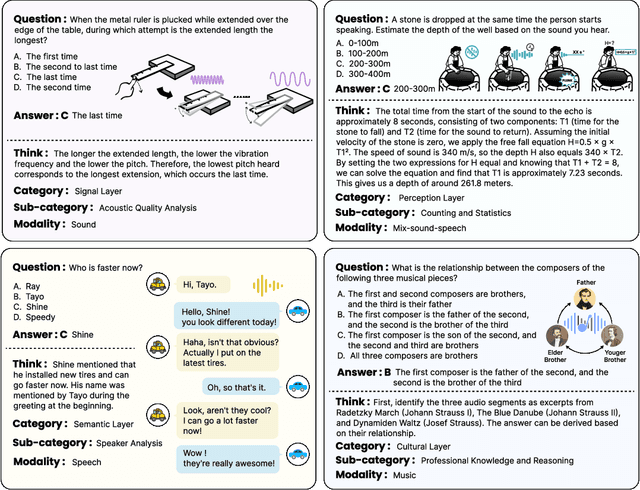
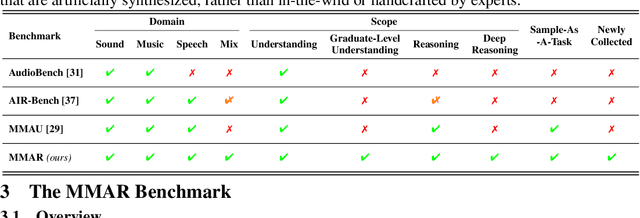
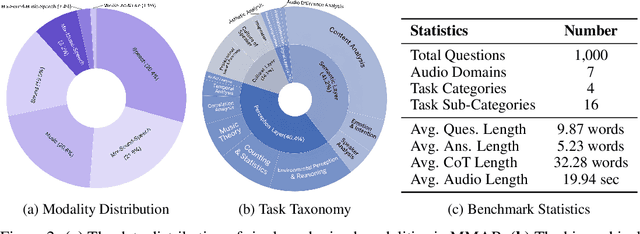
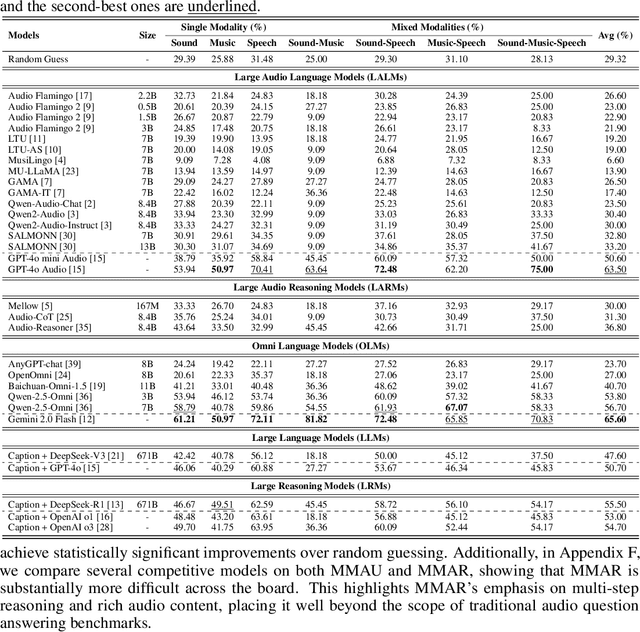
Abstract:We introduce MMAR, a new benchmark designed to evaluate the deep reasoning capabilities of Audio-Language Models (ALMs) across massive multi-disciplinary tasks. MMAR comprises 1,000 meticulously curated audio-question-answer triplets, collected from real-world internet videos and refined through iterative error corrections and quality checks to ensure high quality. Unlike existing benchmarks that are limited to specific domains of sound, music, or speech, MMAR extends them to a broad spectrum of real-world audio scenarios, including mixed-modality combinations of sound, music, and speech. Each question in MMAR is hierarchically categorized across four reasoning layers: Signal, Perception, Semantic, and Cultural, with additional sub-categories within each layer to reflect task diversity and complexity. To further foster research in this area, we annotate every question with a Chain-of-Thought (CoT) rationale to promote future advancements in audio reasoning. Each item in the benchmark demands multi-step deep reasoning beyond surface-level understanding. Moreover, a part of the questions requires graduate-level perceptual and domain-specific knowledge, elevating the benchmark's difficulty and depth. We evaluate MMAR using a broad set of models, including Large Audio-Language Models (LALMs), Large Audio Reasoning Models (LARMs), Omni Language Models (OLMs), Large Language Models (LLMs), and Large Reasoning Models (LRMs), with audio caption inputs. The performance of these models on MMAR highlights the benchmark's challenging nature, and our analysis further reveals critical limitations of understanding and reasoning capabilities among current models. We hope MMAR will serve as a catalyst for future advances in this important but little-explored area.
J1: Exploring Simple Test-Time Scaling for LLM-as-a-Judge
May 17, 2025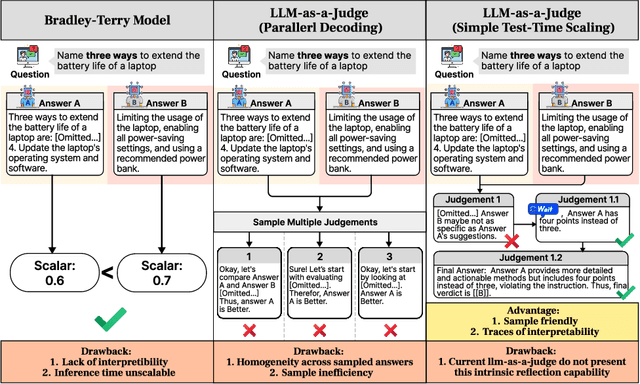
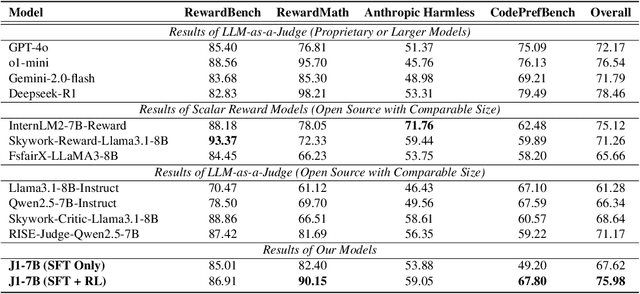
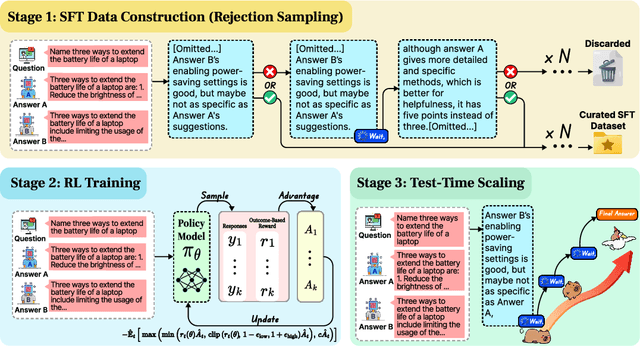

Abstract:The current focus of AI research is shifting from emphasizing model training towards enhancing evaluation quality, a transition that is crucial for driving further advancements in AI systems. Traditional evaluation methods typically rely on reward models assigning scalar preference scores to outputs. Although effective, such approaches lack interpretability, leaving users often uncertain about why a reward model rates a particular response as high or low. The advent of LLM-as-a-Judge provides a more scalable and interpretable method of supervision, offering insights into the decision-making process. Moreover, with the emergence of large reasoning models, which consume more tokens for deeper thinking and answer refinement, scaling test-time computation in the LLM-as-a-Judge paradigm presents an avenue for further boosting performance and providing more interpretability through reasoning traces. In this paper, we introduce $\textbf{J1-7B}$, which is first supervised fine-tuned on reflection-enhanced datasets collected via rejection-sampling and subsequently trained using Reinforcement Learning (RL) with verifiable rewards. At inference time, we apply Simple Test-Time Scaling (STTS) strategies for additional performance improvement. Experimental results demonstrate that $\textbf{J1-7B}$ surpasses the previous state-of-the-art LLM-as-a-Judge by $ \textbf{4.8}$\% and exhibits a $ \textbf{5.1}$\% stronger scaling trend under STTS. Additionally, we present three key findings: (1) Existing LLM-as-a-Judge does not inherently exhibit such scaling trend. (2) Model simply fine-tuned on reflection-enhanced datasets continues to demonstrate similarly weak scaling behavior. (3) Significant scaling trend emerges primarily during the RL phase, suggesting that effective STTS capability is acquired predominantly through RL training.
SongEval: A Benchmark Dataset for Song Aesthetics Evaluation
May 16, 2025Abstract:Aesthetics serve as an implicit and important criterion in song generation tasks that reflect human perception beyond objective metrics. However, evaluating the aesthetics of generated songs remains a fundamental challenge, as the appreciation of music is highly subjective. Existing evaluation metrics, such as embedding-based distances, are limited in reflecting the subjective and perceptual aspects that define musical appeal. To address this issue, we introduce SongEval, the first open-source, large-scale benchmark dataset for evaluating the aesthetics of full-length songs. SongEval includes over 2,399 songs in full length, summing up to more than 140 hours, with aesthetic ratings from 16 professional annotators with musical backgrounds. Each song is evaluated across five key dimensions: overall coherence, memorability, naturalness of vocal breathing and phrasing, clarity of song structure, and overall musicality. The dataset covers both English and Chinese songs, spanning nine mainstream genres. Moreover, to assess the effectiveness of song aesthetic evaluation, we conduct experiments using SongEval to predict aesthetic scores and demonstrate better performance than existing objective evaluation metrics in predicting human-perceived musical quality.
CMD: Controllable Multiview Diffusion for 3D Editing and Progressive Generation
May 11, 2025Abstract:Recently, 3D generation methods have shown their powerful ability to automate 3D model creation. However, most 3D generation methods only rely on an input image or a text prompt to generate a 3D model, which lacks the control of each component of the generated 3D model. Any modifications of the input image lead to an entire regeneration of the 3D models. In this paper, we introduce a new method called CMD that generates a 3D model from an input image while enabling flexible local editing of each component of the 3D model. In CMD, we formulate the 3D generation as a conditional multiview diffusion model, which takes the existing or known parts as conditions and generates the edited or added components. This conditional multiview diffusion model not only allows the generation of 3D models part by part but also enables local editing of 3D models according to the local revision of the input image without changing other 3D parts. Extensive experiments are conducted to demonstrate that CMD decomposes a complex 3D generation task into multiple components, improving the generation quality. Meanwhile, CMD enables efficient and flexible local editing of a 3D model by just editing one rendered image.
 Add to Chrome
Add to Chrome Add to Firefox
Add to Firefox Add to Edge
Add to Edge